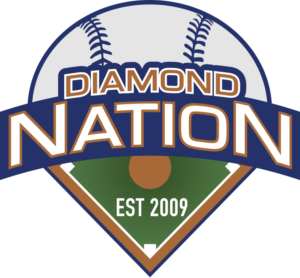Under COVID-19 precautions home plate umpires at Diamond Nation will be calling balls and strikes from behind the pitchers mound.
When Diamond Nation begins its tournament season on Monday, July 6, change will be front-and-center.
And the positioning and mechanics of its umpiring crews will be one of the more obvious adjustments made under COVID-19 precautions.
“I expect it to be seamless,” says Marty Clark, Diamond Nation’s Director of Tournaments and Leagues. “I sat down with five of our veteran umpires who, with me, have more than 200 years of umpiring experience.”
Clark, a veteran umpire of 45 years, oversees the Diamond Nation umpiring crew. Clark had worked 19 straight NJSIAA state championship games before this spring’s high school season was cancelled.
Most striking of the safety precautions Clark and his crew will adopt is the re-positioning of the home plate umpire behind the pitcher’s mound. That, of course, changes the mechanics of the two-man crews that umpire thousands of games played at Diamond Nation each summer.
The home plate umpire, calling balls and strikes behind the pitcher’s mound, will take on new responsibilities as will the base umpire.
The subtle intricacies involved in an umpiring crew managing a game can be lost on the average fan but Clark and his umpires know the drill all too well. The base umpire in a two-man crew has varying positional responsibilities depending on game situations. For example, with no runners on base, the base umpire is behind first base. But with runners aboard he moves to the middle of the diamond for favorable views and to cover more bases. That changes this summer with the plate umpire stationed in the middle of the diamond. The base ump will be more stationary, except when covering home plate in specific situations or in rundowns.
“We umpired a few practice games this week and that was very helpful,” said Clark. “It went really well. We have worked on modifying situations.”
Clark says the plate umpire, in his new spot calling balls and strikes six feet behind the pitcher, will also be responsible for almost all plays at second base and third base. “The plate umpire also has some situations when he’ll have to make calls at home plate,” says Clark. The plate ump also has fair and foul calls down the third base line.
A couple subtle, but important, positioning details for the plate ump include standing off the pitcher’s non-throwing shoulder while keeping out of the center fielder’s line of vision.
The base umpire in the new configuration will start his inning eight to 10 feet behind first base. Clark says the base ump will face a couple situations where he will need to cover home plate. And, of course, he has fair and foul calls down the right field line.
Clark emphasizes, “There will be times when you run into a unique situation in which you and your partner need to read and react. The basic thought of these mechanics is that we are working the three-man system with the plate umpire being Umpire-3 and Umpire-1 at the same time.”
Clark is encouraging his umpires to sacrifice distance for getting a better angle on a call.
Because of the plate umpire’s increased responsibilities, which include covering second base on steal attempts and all plays at second and third base, the base umpire will have to rotate to home plate in certain situations to make calls there.
While the plate ump will handle calls at home plate on tag ups at third base and throws home on infield grounders, the base ump will rotate to home plate on all plays where the runner originates from second base or first base.
Additional safety precautions
Teams will be encouraged not to throw the ball around the infield after an out to limit touches. Both umpires will wear ball bags to ensure the safety of the balls. Excess balls will be kept in a bag on the netting adjacent to first base.
Diamond Nation has also published a detailed COVID-Safe Reopening Plan for players, umpires and fans to ensure a safe and successful start to the tournament season.

